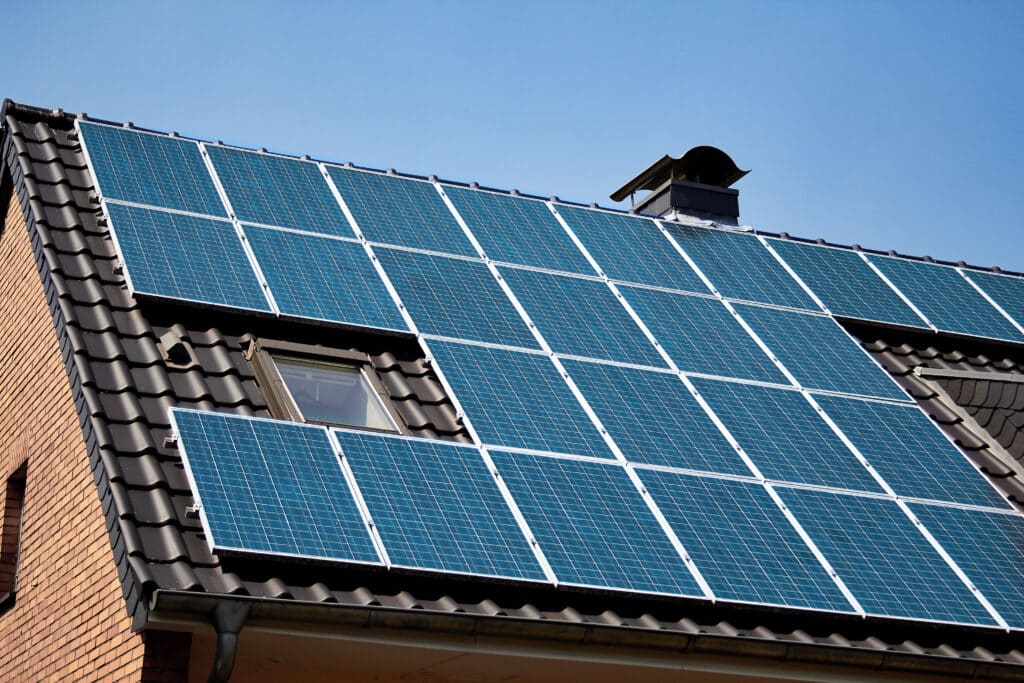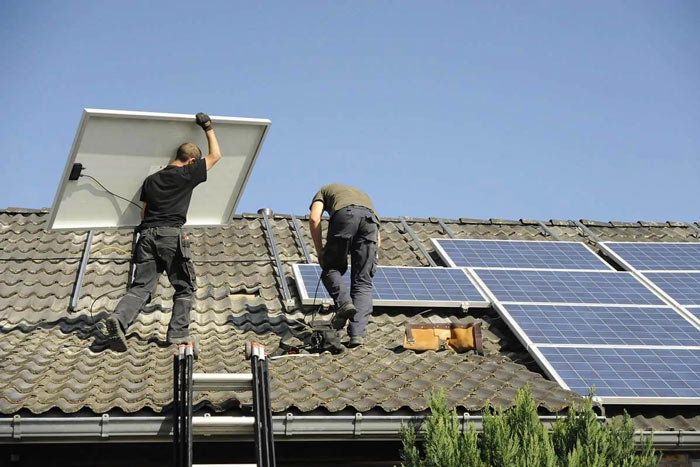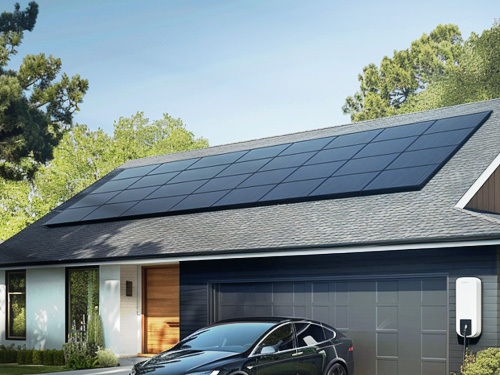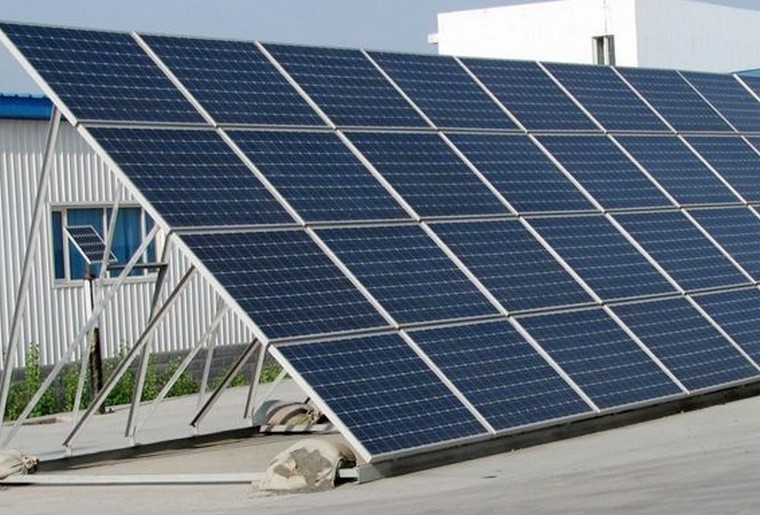Polycrystalline solar panels provide an efficiency of about 15-17% in converting sunlight into energy. These are pretty budget-friendly for a 5 kW system, with costs lying in the range of $0.70-$1.00/watt. You would save more than $1,500 compared to the costs associated with monocrystalline panels. The panels create 20 kWh/day for an average household, and this is highly great for big areas.
What Are Polycrystalline Panels?
Polycrystalline solar panels, sometimes referred to as multi-crystalline panels, are pieces of silicon crystals melted together, giving a speckled blue color and not as smooth an appearance as that of the mono-crystalline. Unlike the mono-crystalline panels made from a single silicon crystal, polycrystalline panels are made by pouring molten silicon into a square mold, where it cools and crystallizes into the multi-crystalline structure. Consequently, this process is quicker and lighter on resources and generates less material waste. The usual efficiency of the polycrystalline panels falls within the range of 15 to 17%; they can convert about 15-17% of sunlight that falls upon them into usable electricity.
A polycrystalline panel with a power rating of 300 watts under standard test conditions—that is, irradiance of 1,000 W/m², with a cell temperature of 25°C and an air mass of 1.5—would be expected to deliver approximately 45 to 51 watts per square meter. The effectiveness is, however, lower than that of monocrystalline panels since the various crystals in one polycrystalline panel create internal boundaries that obstruct the free flow of electrons and thus increase the recombination rate, which decreases the energy conversion efficiency to levels between 15 and 17%.
Polycrystalline panels are gaining more acceptance for residential, commercial, and industrial solar installations due to a compromise between efficiency and price. Specifically, polycrystalline panels currently cost in the range of $0.70 to $1.00 per watt, while monocrystalline panels have a per-watt price of $1.00 to $1.25. For the basic 5-kW residential solar power installation, the total panel cost can be reduced by $1,500 to $2,500 when using polycrystalline panels compared to a similar installation of monocrystalline panels. This makes polycrystalline panels pretty cost-effective, thus making them quite attractive for large installations where area is not much of a constraint and the highest cost factor is essentially the initial investment in solar panels.
How They Work
Polycrystalline panels are built on the photovoltaic effect: when photons from sunlight hit the silicon atoms in the cell, they detach electrons and initiate an electric current. This current is DC (direct current), meaning that it flows in one direction through the circuit. However, this DC produced by the panels is not usable in most household appliances since they require AC (alternating current). For this electricity to become usable, the DC output coming out from the polycrystalline panels must first pass through an inverter, which then changes the current to AC and readies it either for house usage or commercial purposes.
Inverter systems, whether with string inverters, microinverters, or power optimizers, play a critical role in maintaining overall system efficiency. The usual conversion efficiency is from 90-96%, depending on the inverter class that is used. Higher class inverters have smaller conversion losses. Assuming a DC power production of a polycrystalline panel at 300 watts, the AC power output would be approximately 282 watts using an inverter with an efficiency of 94%. This 6% conversion loss is relatively small but builds up over time and affects energy yield, especially for big systems. Therefore, in designing a solar system, understanding the efficiency of the inverter relative to panel output is essential, as it directly affects system performance and energy production.
Temperature might also affect the actual performance of polycrystalline solar cells. Normally, a polycrystalline panel has its temperature coefficient around -0.5% per °C, meaning power output goes down by around 0.5% for every degree centigrade above 25°C. This becomes quite prominent in hot climate areas where the temperature of panels can reach up to 40-45°C, which means one can lose around 7.5-10% of the power output. Therefore, in high-temperature ambient areas, this temperature-related loss in efficiency may justify the use of cooling mechanisms for the panels, such as mounting systems where the air can flow and cool the back of the panel.
Pros of Polycrystalline Panels
The major advantage of polycrystalline panels is the inexpensive method of production. The manufacturing of polycrystalline panels requires a much simpler and less precise crystallization process, which gives significant material and energy savings. A 10 kW polycrystalline solar array may cost in the area of $7,000 to $10,000, while a similar monocrystalline array would fall in the range of $9,000 to $12,500. This cost difference makes polycrystalline panels especially popular among customers who have a smaller budget and for large commercial installations where maximization of initial investment return is important.
Another advantage of polycrystalline panels is their suitability for small installations without a need for the highest efficiencies. A house using an average of 600 kWh per month would find that a 5 kW polycrystalline system—a system that produces under optimum conditions about 20 kWh/day—is sufficient. This setup would give them sufficient energy for the average household in areas that get minimal sunlight, hence a more realistic and acceptable approach for home consumers.
Shading Sensitivity Factor: Polycrystalline panels are less sensitive to shading compared to the monocrystalline ones. Since they are made of multi-crystals, a polycrystalline panel can work comparatively well when small portions of it are shaded from the sun. What this means in practice is that, under partial shading—a tree or other obstruction that could not be avoided in the installation of the panels—polycrystalline panels may be able to sustain more consistent power output. For example, if it is assumed that in a partially shaded setup by a nearby structure, a 10% shaded polycrystalline panel can still manage to provide upwards of 80-85 percent of its rated output, then that would make it the preferable option in such circumstances.
Cons to Consider
One of the major disadvantages with polycrystalline panels is that they are less efficient in converting energy, and hence this requires more space for the same power output as compared to the monocrystalline ones. This would mean that a 10 kW polycrystalline system could take up to about 60 square meters of space, while a similar capacity monocrystalline system could require only about 45 square meters of space. This space difference may prove to be the most important factor for installations where only limited area is available, as on city rooftops or other tight commercial spaces.
Another important limitation of polycrystalline panels is that these can result in performance loss at high temperatures. Unlike the monocrystalline panels, which are usually more resistant to heat, the efficiency of polycrystalline solar panels noticeably drops off at higher temperatures due to its multi-crystalline makeup. For instance, in regions where the temperature normally soars above 35°C, a 300-watt polycrystalline panel will yield only about 270-280 watts, while a monocrystalline panel could yield up to 285-290 watts under the same conditions. This temperature coefficient, normally around -0.5% per °C for polycrystalline panels, can significantly impact overall energy generation in warm climates and should be integrated into the choice of panel types.
Further, polycrystalline usually has a shorter life expectancy than mono-crystal panels. Even though both types normally have up to 25 years of warranty, the degradation of polycrystalline panels is a bit faster and often at a rate of about 0.7% per year, compared to 0.5% for mono-crystal panels. A polycrystalline panel may retain about 82.5% of its output after 25 years, while a mono-crystal panel may retain up to 87.5%. This, in turn, can help with determining the feasibility of large-scale installations or projects for which longevity may be one of the key issues and the lifetime return on investment.
Polycrystalline vs. Monocrystalline
One of the main differences when comparing the two to each other, polycrystalline to monocrystalline panels, has to do with efficiency. The energy conversion efficiencies of monocrystalline panels tend to be higher, ranging between 18-22%, while for polycrystalline panels these are between 15-17%. This efficiency gap means that a 10 kW monocrystalline system would generate 5-10% more electricity than its polycrystalline counterpart, which is about 50-100 extra kWh per month in sunny areas. For example, in a household that consumes about 1,000 kWh a month, this additional output could cover an extra 5-10% of its energy needs.
Another relevant factor is longevity and the rate of degradation. Monocrystalline panels, as many would argue, ensure durability and slow degradation. Given the degree of degradation at about 0.5%, over time, monocrystalline panels could retain more of their original capacity, which could be relevant for calculating long-term ROI. For instance, over a 25-year time period, a 5 kW monocrystalline system would produce approximately 1,250 kWh more than a similar polycrystalline system, taking into account both the efficiency and degradation differences.
Aesthetically, monocrystalline panels are sleek and black with a uniform look. Contributing much to that fact, many find them really good to look at, especially the single-crystal structure, is the basis of the reason for residential rooftops. On the other hand, polycrystalline panels have a blue tint with speckles. Though not as aesthetically pleasing in comparison, they are more common on larger commercial installations than their monocrystalline equivalents, where aesthetics come second to cost and space utilization. Utility-scale solar farms, for example, employ polycrystalline panels in an effort to cut costs and increase energy output over large expanses.
Cost-Effectiveness
Considering the cost, polycrystalline panels always tend to be the winner in large-scale installations in which the leading factor is budget. Because the production process for polycrystalline panels is simpler, they often cost 10-20% less than monocrystalline panels. For instance, in a commercial installation that requires a 1 MW solar system, it may save between $100,000 and $200,000 by choosing polycrystalline panels over their monocrystalline counterpart, which could be pretty substantial in terms of initial capital investment.
Long-term cost-effectiveness may be less favorable when the panels are being used under circumstances of particularly high energy demand or in areas that charge high rates for electricity. The lower efficiency and higher degradation rate for the polycrystalline panels suggest that, over a 25-year system lifespan, a polycrystalline system may generate 5-10% less energy compared to a similarly sized monocrystalline system. In an area where electricity costs $0.15 per kWh, this reduction in energy output could translate to around $4,000-$5,000 in lost savings for a 10 kW system, affecting the overall financial return on investment (ROI).
In this case, it is also where polycrystalline panels are more often an economically viable option for residential customers when budget space is thin and cannot allow for the utmost in efficiency. For the average household, which consumes 600 kWh per month, it would have its needs fulfilled with a 5 kW polycrystalline system at an estimated $7,500, compared with an estimated $9,000 for a monocrystalline system. The $1,500 savings may make polycrystalline an extremely appealing option, even when slight compromise needs to be made in output efficiency and long-term energy production.
Are They Right for You?
Generally, polycrystalline panels are ideal for residential or commercial projects when either budgetary or space constraints do not play a major role. School projects, municipality buildings, and even agricultural installations can take into account polycrystalline panels according to priorities with upfront cost savings rather than efficiency. With a similar system for a school installation, savings can be as high as $10,000-$20,000 for a polycrystalline installation against the use of a monocrystalline one. In doing so, the institution is able to conserve resources that could be used elsewhere while still enjoying substantial energy savings.
In the case of highly energy-consuming users or long-term savings, it would be more appropriate to use monocrystalline panels, although their upfront cost is much higher. For example, businesses that have energy-intensive processes or residences that live in areas with higher rates of electricity may see that additional production from monocrystalline panels yields an overall better ROI over time.




